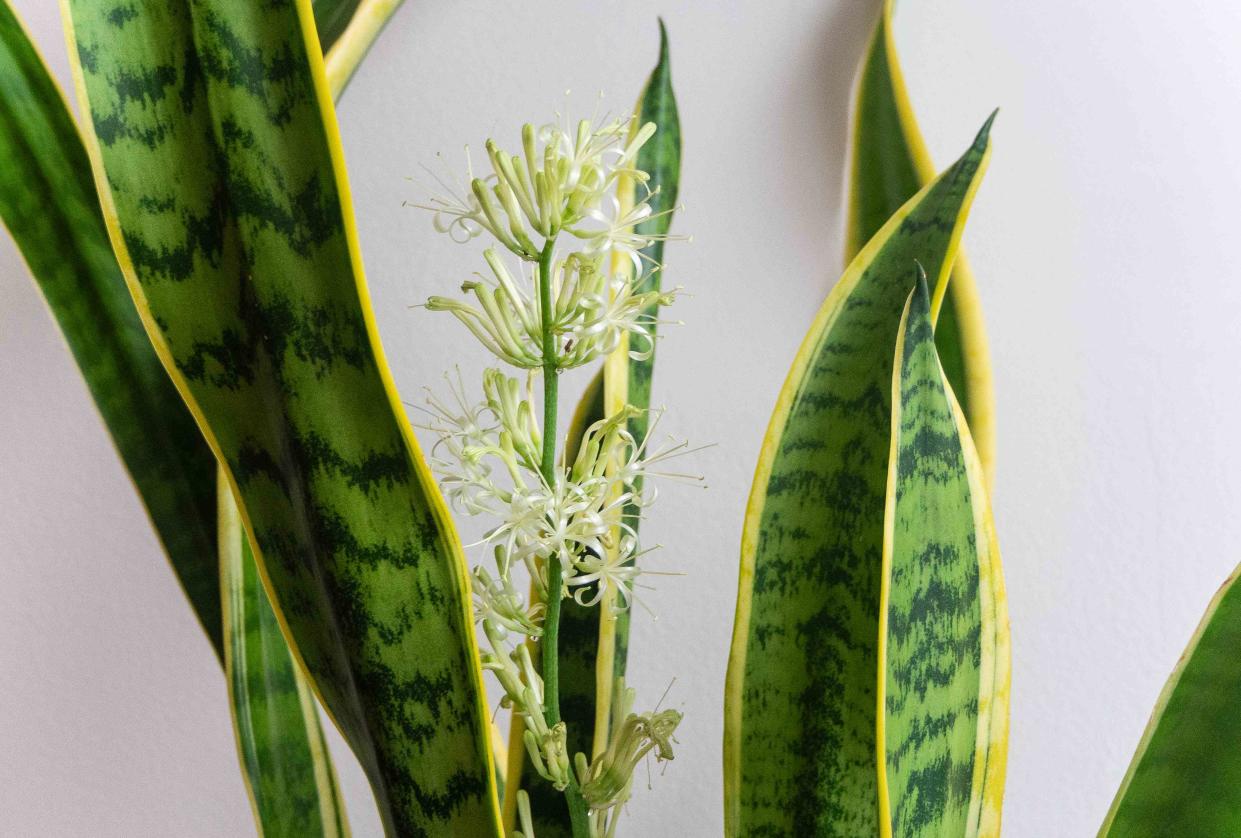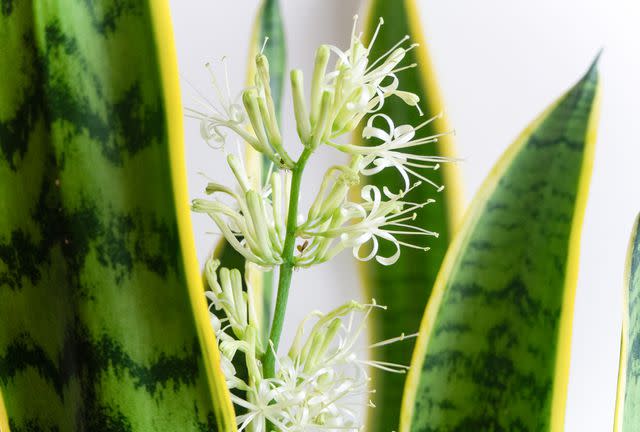How to Get a Snake Plant to Bloom Indoors

The Spruce / Valerie de Leon
Snake plants bloom annually in their native habitat, but like many other tropical species grown indoors as houseplants, flowering either occurs randomly and rarely or it must be forced. If you want to get a snake plant to flower and bloom, it's going to take some calculated neglect (yes, really). That's a bit tricky but experimenting with this very forgiving plant isn't too risky. The challenge is to create the right amount of stress without going overboard.
Here's what you need to know about how to get a snake plant to bloom indoors.
Snake Plant Flower
Snake plant flowers are fragrant, spidery blooms in white, yellowish green, or even shades of burgundy to pink depending on the variety of snake plant. The first sign your plant is preparing to bloom is the appearance of a thin, green flower spike emerging in the center crown of leaves. This happens most often in spring after the plant has come out of winter dormancy. Small green buds develop along the stem which can stretch up to 3 feet in height.
Snake plant flowers open at night, starting at the bottom of the spike and moving upwards, emitting a strong scent described as vanilla or jasmine. The blooming may be followed by bright orange berries. Snake plants grown indoors must be hand pollinated to produce these colorful but inedible fruits. The entire plant is mildly toxic to pets and humans.
Once blooms drop, the rosette (cluster) of leaves will not produce a second bloom, but the plant will retain its signature, long slender foliage.

The Spruce / Valerie de Leon
Types of Snake Plants That Bloom
There are 70 different varieties of snake plant and not all of them flower, so be sure to choose one that does. Here are a few of the more reliable bloomers.
Dracaena trifasciata
Dracaena gracilis
Dracaena longiflora
Dracaena patens
How to Make a Snake Plant Bloom
Flowers are rarely seen on snake plants grown indoors. Coaxing one into bloom requires experimenting with growing conditions. It's easy to neglect this undemanding houseplant, and growers are often surprised to discover flowers on an unattended plant.
But if you want to get a snake plant to bloom on purpose, it will require inadequate care to stress the plant. The plant will produce flowers and seeds to ensure its survival despite the neglect.
Maturity
A young snake plant will not bloom and stressing it is more likely to lead to its death than if you had a mature plant. If you want to try to force your plant to flower, wait until it is at least 2 years old.
Space
A root-bound plant is more likely to bloom that one with plenty of space to expand. When the entire pot is filled to the inside edge with roots, wait a growing season or two before repotting it to create conditions where it might flower.
A little stress from crowding is okay but watch for signs your plant is ailing, like stunted or dying leaves.
Light
Giving your plant sufficient light is the key element to forcing bloom. Snake plants survive in low light but grow too slowly to flower. They prefer up to 6 hours of indirect light and tolerate a couple of hours of bright sunlight daily. Placement in or near a southeast facing window at the start of the growing season improves a chance for flowers. If you don't have enough natural light in your home, a grow light can provide supplemental lighting.
Water
Snake plants are drought tolerant and, if picky about anything, don't like too much water. Letting the soil dry completely before watering adds a little stress for encouraging bloom. You'll need to experiment to find the right balance. When water runs straight through soil and out the drainage holes, the plant is being deprived of the nutrients it needs to flower.
Fertilize
Feed your plant in early spring and mid-summer with a balanced NPK 10-10-10 houseplant fertilizer. Or dilute to half strength and feed once a month or every six weeks during the growing season. Do not fertilize during autumn and winter and avoid fertilizers sold as bloom boosters which can cause salt buildup in the potting mix.
Frequently Asked Questions
Why is my snake plant blooming?
An indoor snake plant that blooms is likely doing so because some neglect made it stressed. Plants bloom to insure their survival. Blooms, when pollinated, produce fruits and seeds which translate to potential new plants. If grown indoors it's unlikely to produce berries to complete the life cycle.
Should you repot a snake plant after it blooms?
Don't repot a snake plant right after it blooms. Because a flowering snake plant is already stressed, you will only further stress it by repotting. Remove spent flowers spikes at the base and resume normal care for your plant for the current growing season.
How long does snake plant bloom?
Snake plant flowers last for two to three weeks depending on variety, opening at night with a fragrance comparable to vanilla or jasmine.
Read the original article on The Spruce.

